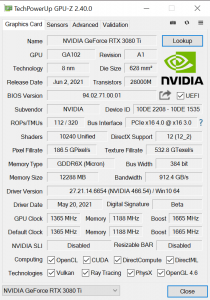Hot on the heels of Nvidia's announcement at Virtual Computex 2021, today we can present our review of the RTX 3080 Ti. Built on the same GA102 GPU as the RTX 3080 and the RTX 3090, the RTX 3080 Ti sports a total of 82 Streaming Multiprocessors, only two fewer than the RTX 3090. Its memory allocation has been halved, with 12GB of GDDR6X which also runs fractionally slower. How much difference will those tweaks make to real world gaming though? That's what we find out today.
As part of this review, we will of course be focusing on Nvidia's RTX 3080 Ti Founders Edition, which uses the same cooler as the RTX 3080 that launched back in September. We do also have three AIB cards to include as part of this day one review, which will make an interesting comparison for the Founders Edition.
The first of these is Gigabyte's RTX 3080 Ti Gaming OC, a now-familiar looking triple-fan card. In fact, all three partner models are use thick triple-fan coolers, with the other two in question being the Palit RTX 3080 Ti GameRock OC and the Inno3D RTX 3080 Ti iChill X4.
| RTX 3090 | RTX 3080 Ti | RTX 3080 | RTX 3070 | RTX 3060 Ti | |
| SMs | 82 | 80 | 68 | 46 | 38 |
| CUDA Cores | 10496 | 10240 | 8704 | 5888 | 4864 |
| Tensor Cores | 328 | 320 | 272 | 184 | 152 |
| RT Cores | 82 | 80 | 68 | 46 | 38 |
| Texture Units | 328 | 320 | 272 | 184 | 152 |
| ROPs | 112 | 112 | 96 | 96 | 80 |
| GPU Boost Clock | 1695 MHz | 1665 MHz | 1710 MHz | 1725 MHz | 1665 MHz |
| Memory Data Rate | 19.5 Gbps | 19 Gbps | 19 Gbps | 14 Gbps | 14 Gbps |
| Total Video Memory | 24GB GDDR6X | 12GB GDDR6X | 10GB GDDR6X | 8GB GDDR6 | 8GB GDDR6 |
| Memory Interface | 384-bit | 384-bit | 320-bit | 256-bit | 256-bit |
| Memory Bandwidth | 936 GB/Sec | 912 GB/Sec | 760 GB/Sec | 448 GB/Sec | 448 GB/Sec |
| TGP | 350W | 350W | 320W | 220W | 200W |
As mentioned, the RTX 3080 Ti uses Nvidia’s GA102 GPU, but a slightly cut-down version of the silicon. That means the RTX 3080 Ti incorporates 80 Streaming Multiprocessors (SMs), and thanks to Ampere’s new SM structure with its two FP32 datapaths, each SM houses 128 CUDA cores, giving a total of 10240. This is only 256 fewer cores compared to the RTX 3090, a reduction of 2.4%.
Ampere also places one RT core, and four Tensor cores, in each SM, giving a total of 80 RT cores and 320 Tensor cores. This is accompanied by 320 texture units and 112 ROPs which are now housed directly within each graphics processing cluster (GPC), with 16 ROPs per GPC, and 7 GPCs in total for RTX 3080 Ti.
Clock speed is another area where Nvidia has made cut backs compared to the RTX 3090. The RTX 3080 Ti Founders Edition has a reference clock of 1665MHz, a reduction of 30MHz against the RTX 3090, though all three of the partner cards we test come factory overclocked. We test real-world clock speed behaviour later in this review.
For the memory, Nvidia is using the same 384-bit bus as found with the RTX 3090. The memory allocation itself has been halved, to 12GB of GDDR6X, while it also comes clocked at 19Gbps instead of 19.5Gbps as with the RTX 3090.
Lastly, for total graphics power, Nvidia rates the RTX 3080 Ti for 350W, the exact same as the RTX 3090. This review is the first where we will debut our new GPU power testing methodology, so read on for our most detailed power testing yet.
 KitGuru KitGuru.net – Tech News | Hardware News | Hardware Reviews | IOS | Mobile | Gaming | Graphics Cards
KitGuru KitGuru.net – Tech News | Hardware News | Hardware Reviews | IOS | Mobile | Gaming | Graphics Cards




